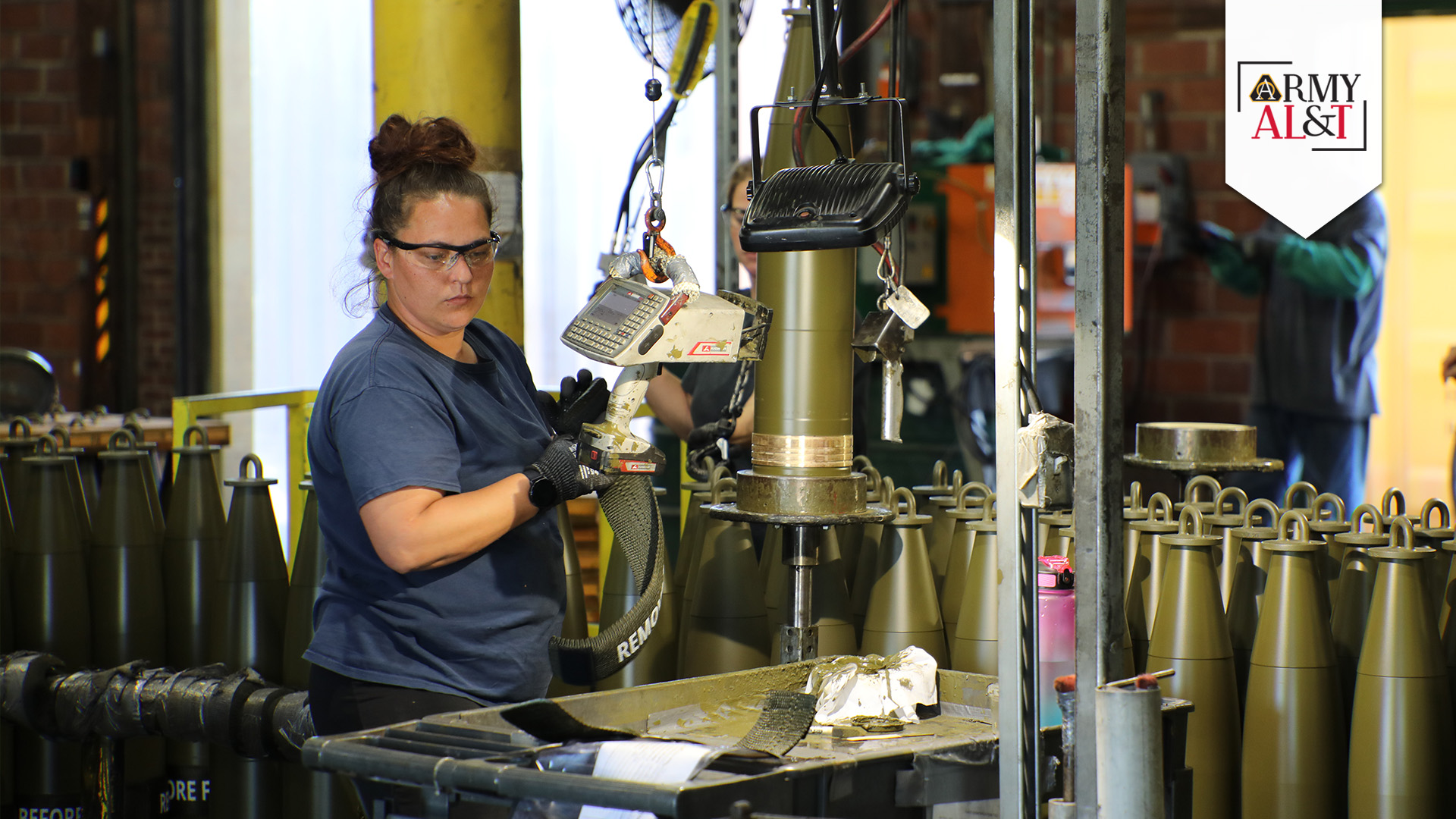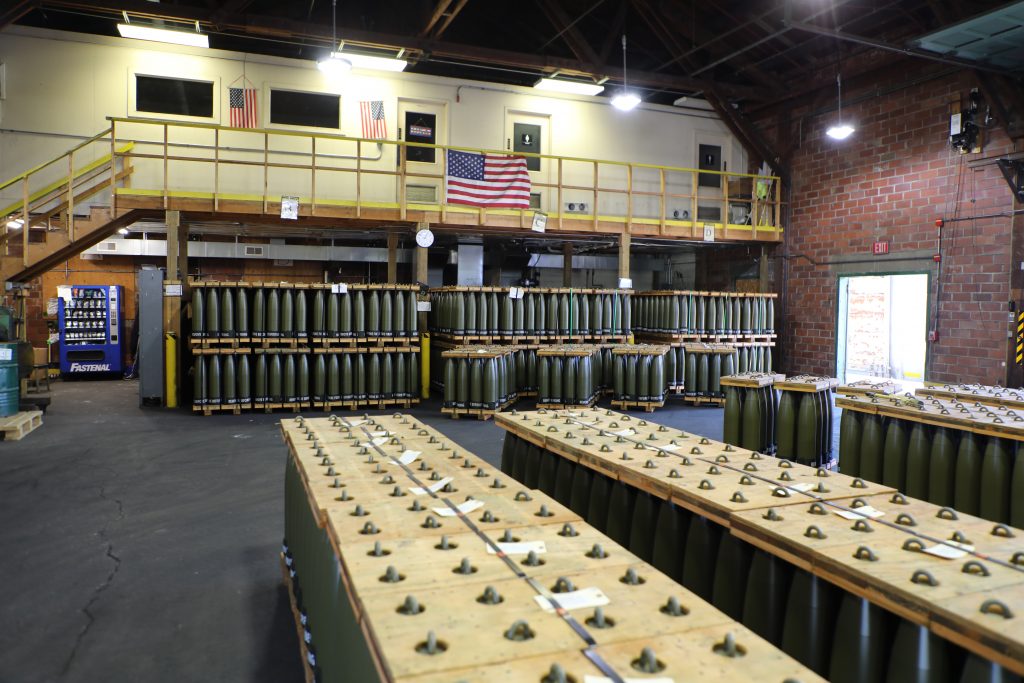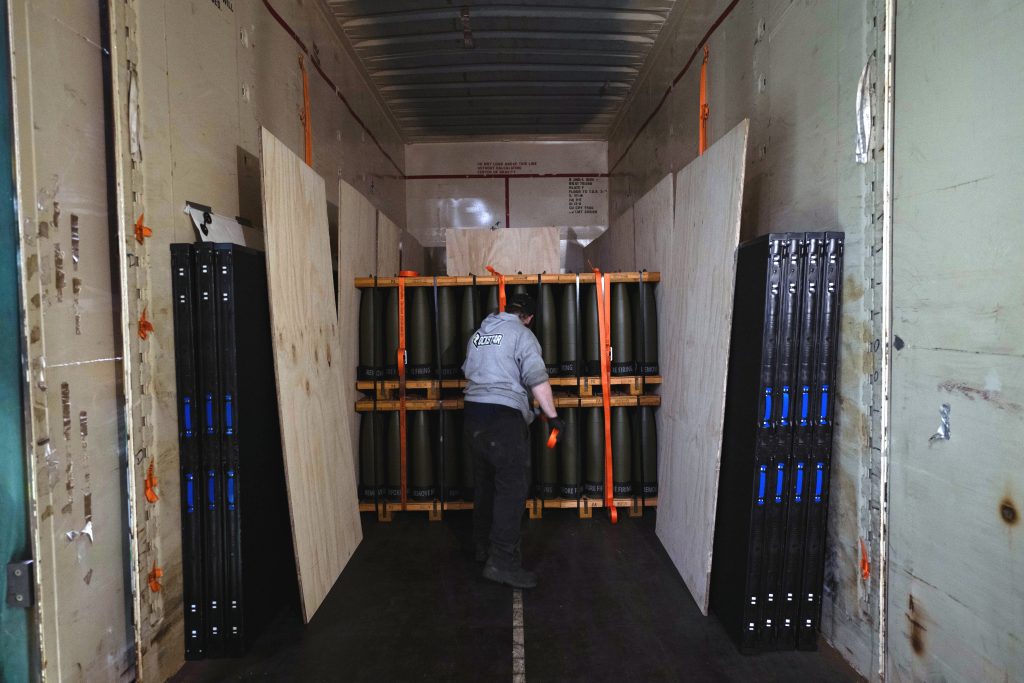
PACK OUT: An IAAAP employee prepares 155 mm rounds for load, assemble and pack, May 15, 2024. (Photo by Dori Whipple, Joint Munitions Command, Public and Congressional Affairs)
Joint Munitions Command plays integral part in aid to Ukraine.
by Brig. Gen. Ronnie Anderson Jr.
The U.S. Army’s Joint Munitions Command (JMC) has played a vital role in providing support to Ukraine amidst its ongoing conflict with Russia.
JMC is responsible for the production, storage, distribution and demilitarization of conventional munitions for the U.S. Department of Defense. JMC’s contributions—mainly 155 mm artillery rounds—have been crucial in bolstering Ukraine’s defensive and offensive capabilities and reflects a broader commitment to international security and strategic partnerships.
SCALING UP PRODUCTION
In response to the heightened demand, JMC, along with Joint Program Executive Office Armaments and Ammunition (JPEO A&A) and industry partners, has undertaken substantial efforts to increase production levels of 155 mm rounds. Before the conflict, production rates were relatively modest, with only 9,000 rounds produced monthly between 2009–2017 at the Scranton Army Ammunition Plant (SCAAP). Now, 15,000 rounds per month are being produced at SCAAP, reflecting the immediate need to support Ukraine’s military efforts.
SCAAP, a government-owned, contractor-operated (GOCO) site, manufactures large-caliber metal projectiles—including 155 mm—for the joint warfighter. The Iowa Army Ammunition Plant (IAAAP), also a GOCO, loads, assembles and packs medium- and large-caliber rounds, including 155 mm. IAAAP and SCAAP are two of more than a dozen subordinates of JMC.
“We couldn’t have ramped up production without the tireless efforts of our workforce. Their skilled labor, adaptability and commitment were crucial in meeting the increased demand during these critical times,” said Rich Hansen, the commander’s representative at SCAAP. “Our workers’ ability to quickly adopt new techniques and maintain high-quality standards have helped ensure that SCAAP could efficiently produce the necessary ammunition.
“We are proud of the work our employees do day in and day out,” Hansen added. “They consistently demonstrate dedication and a commitment to excellence that drives our success.”

WELL-SUPPLIED: Storage of 155 mm projectiles at the IAAAP, May 15, 2024. (Photo by Dori Whipple, Joint Munitions Command, Public and Congressional Affairs)
MODERNIZATION OF THE OIB
The sharp increase in production has been facilitated by ongoing modernization across JMC’s organic industrial base (OIB). These efforts are part of a comprehensive 15-year OIB modernization plan the Army has implemented to enhance the efficiency and capacity of its munitions production facilities.
Key aspects of this modernization include advanced manufacturing technologies, supply chain optimization and infrastructure upgrades.
At SCAAP, modernization efforts include the refurbishment and addition of multiple long stroke vertical hydraulic forge press lines, more than 100 hydraulic tracer and Computer Numerical Control lathes, multiple automated paint lines and multiple heat treat furnaces for steel. At IAAAP, the Army is creating a new Future Artillery Complex where digital manufacturing will be included in the design of the complex. Additionally, IAAAP has a coal elimination strategy that will result in resilient and efficient decentralized boiler systems for steam production. Steam production is used during the manufacturing process and as comfort heating for the building. Last October, ground was broken for a state-of-the-art metrology laboratory at IAAAP. The laboratory is essential for the correct calibration of measurement instruments for their effective use on the artillery production line. This assures that all items are manufactured to the same standards.
“We are transforming how we operate to meet the demands of a rapidly changing environment,” said Lt. Col. John Dunlapp, IAAAP’s commander. “The changes we have made and have planned enable us to enhance our efficiency. By updating our processes, we ensure relevance and resilience and equip ourselves to adapt and to better serve our stakeholders.”
ORDERS FULFILLED AT SPEED OF RELEVANCE
Without partnerships and support from other commands within the Army, such as U.S. Transportation Command (USTRANSCOM) and JPEO A&A, as well as private industry, JMC wouldn’t be able to provide ammunition at the current volume and velocity necessary to support Ukraine.
Around $50 billion in military aid has been provided by the U.S. to Ukraine since Russia’s full-scale invasion in February 2022. JMC has requested more than 7,000 Transportation Protective Service trucks through USTRANSCOM and Military Surface Deployment and Distribution Command, the Army’s service component command to USTRANSCOM, to deliver munitions from eight installations—Anniston Munitions Center, Blue Grass Army Depot, Crane Army Ammunition Activity, Hawthorne Army Depot, Letterkenny Munitions Center, McAlester Army Ammunition Plant, Tooele Army Depot and IAAAP—to six airfields and one seaport for shipment in support of Ukraine.
With assistance from rail and trucking partners, JMC distributed an additional 6,311 containers (59,105 short tons) of munitions—3,757 containers by rail and 2,554 by truck—to port terminals.
Through special assignment airlift missions, or SAAMs, JMC executes orders at the speed of relevance. JMC’s yearly average of SAAM execution is typically 80 per year, but in the past 12 months it has executed over 430 SAAMs of ammunition in support of Ukraine.
The normal planning timeframe for a SAAM is approximately 45 days from receipt of requirement to SAAM departure, but JMC and the Defense Travel System enterprise have reduced it to five days. The normal timeframe for a sustainment vessel is approximately 135 days from identification of requirements to final delivery to the seaport of embarkation, and the enterprise has been able to execute this process in as little as 11 days through extraordinary coordination to meet emerging requirements.
“Thanks to a collective team effort across the OIB and with our partners, we have been able to streamline processes and improve resource management,” said Gina Ward, JMC’s munitions logistics director. “This collaboration has led to faster delivery times, increased reliability and enhanced readiness.”

READY TO GO: An employee prepares 155 mm projectiles for distribution at SCAAP, March 26, 2024. (Photo by Henry Villarama, Headquarters Department of the Army)
CONCLUSION
JMC executes orders at the speed of relevance, and the command’s vision is to ensure excellence in munitions readiness and sustainment through continual innovation and modernization.
JMC will steadfastly and resolutely continue to provide essential ammunition to the brave and valiant soldiers in Ukraine, ensuring their safety and empowering them to defend their homeland. This effort upholds our unwavering international commitments to peace, freedom and stability in the region.
JMC’s actions reflect the enduring spirit of solidarity, patriotism and dedication to democratic values that define the nation.
For more information about JMC and its mission, go to https://www.jmc.army.mil. For more information about U.S. support to Ukraine, go to https://www.defense.gov/Spotlights/Support-for-Ukraine/.
BRIG. GEN. RONNIE ANDERSON JR. assumed the duties of Commander of JMC on June 1, 2023. He was commissioned as an Ordnance officer from Purdue University in 1996. He holds an M.S. in strategic studies from the Marine Corps University, an M.S. in logistics management from the Florida Institute of Technology and a B.S. in industrial management from Purdue University.







